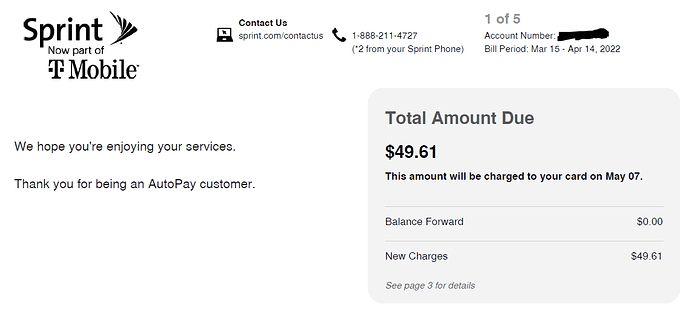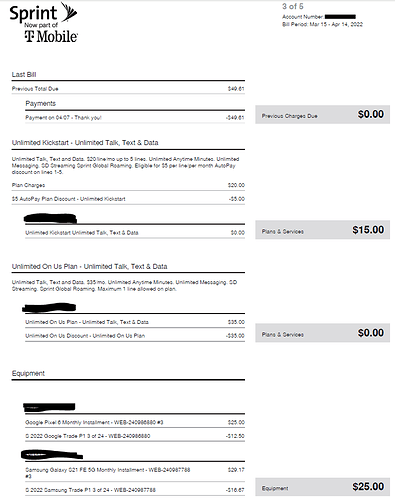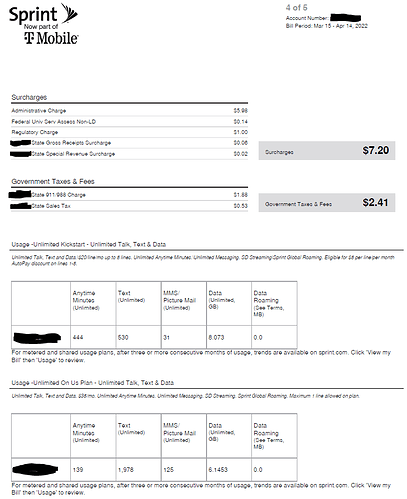TL;DR It’s old and it’s T-mo, but not family based. It’s one line of Sprint Unlimited Kickstart + one line of Unlimited On Us. It took work and good timing to get it that low with just two lines. I know you didn’t ask for this, but here’s the long version.
For years I had Sprint SERO grandfathered from the early days of the Blackberry/Windows Mobile era (around 2006). Where I lived, at the time, Sprint coverage was about as good as AT&T, better than T-Mobile, and worse than Verizon. But Verizon cost twice as much. Sprint’s SERO started at $30/month and eventually became $40 years later by adding $10/mo for “premium data” when you switched to an Android phone. With taxes and fees, it stayed right below $50/mo and it was always unlimited data. Calling became unlimited at some point. They also added free 3G international data too. I assume that add on was in response to all the other networks improving faster than Sprint and so many people leaving to cheap MVNOs. That was also shortly after the time that the legacy carriers stopped offering several a hundred dollar discount on buying a new phone from them every 2 years. My Galaxy S6 purchase in 2015 got in right before that custom ended. I almost switched to a discount MVNO in 2016 as Sprint now had the worst coverage in my area, but held off hoping for something really good.
Then in 2018, something really good came along. Sprint offered Unlimited Kickstart to new customers. $20/mo unlimited calling/data (with the possibility of network congestion throttling) and a $5 discount for auto-pay. So $15/mo for the best plan on the worst (but usable) network. I had to cancel my Sprint plan and pay to port my number to T-Mobile in order to be a new customer. That was a nerve racking experience getting rid of a 9 year old grandfathered plan that was still a good deal. But there were enough people that posted how they did it, so I was hopeful it would work. Since I did the switch on the last day of eligibility, I ended up having to be on the phone with them for hours to get it working. It was worth it in the end. Since the eligibility for it was over the next day, I didn’t get my wife switched over to it. But a couple months later, they ran the same promo (Unlimited Kickstart) at a different price point - $30/mo with a $5/mo auto-pay discount. Up to this point, I had my wife on different MVNOs as promos popped up and as she needed new phones so it was nice to have her on a plan I knew we wouldn’t switch. $40/mo + tax/fees for 2 unlimited lines was as good as it gets, or so I thought.
Not long after T-Mobile bought Sprint in the summer of 2020, I was worried that they would get rid of our grandfathered plans. But not only did they say they would keep Sprint customers on their old plans, they offered a free unlimited line (w/ throttling) to everyone. So I ported my wife out of her $25/mo plan and then added her to my plan for free. So now we had two unlimited lines on one plan for $15/mo plus fees. That came to $25/mo.
Then this year T-Mobile brought back the new phone discount - even for my wife’s free line. They offered the Pixel 6 and Galaxy S21 FE (and other phones) for $300 spread over 24 months as monthly bill credits when trading in an old phone. At the time, from T-Mobile, the Pixel 6 was $600 and the Galaxy S21 FE was $700 (but you could get it for $600 from Samsung). So I’m paying $12.50/mo for each phone for 24 months = $300 each.
If I weren’t getting this deal myself, I wouldn’t believe it. My wife is frugal, but I don’t think she has any concept about how much we are actually saving above the average family. So I guess my claim that people can save tons on their cell phone bill while posting what I pay was 50% realistic (people can save) and 50% humble-brag (but they aren’t likely to duplicate my bill).


